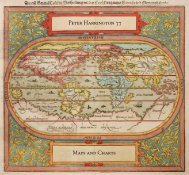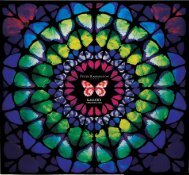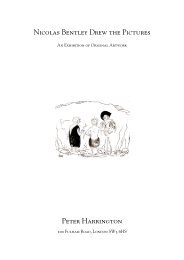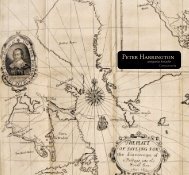antiquarian bookseller - Peter Harrington
antiquarian bookseller - Peter Harrington
antiquarian bookseller - Peter Harrington
Create successful ePaper yourself
Turn your PDF publications into a flip-book with our unique Google optimized e-Paper software.
<strong>Peter</strong> <strong>Harrington</strong> Antiquarian Bookseller<br />
262.LEAR, Edward.<br />
Journal of a Landscape Painter in<br />
Corsica.<br />
London, Robert John Bush, 1870 [18169] £600<br />
Large 8vo (263 × 184mm). Modern burgundy full calf,<br />
wavy line panel to the boards, raised bands, spine gilt in<br />
compartments, top edge gilt. Frontispiece and 39 other plates,<br />
full-page map, numerous text illustrations. Slight foxing to the<br />
half-title, else a good clean copy.<br />
FIRST EDITION. “With the failure of his artistic ambition,<br />
he began to consider living permanently abroad. The<br />
savings from his publications, and a small legacy from<br />
[his mother], meant that he could afford to build a house<br />
where he would live quietly and paint. He needed now to<br />
find a suitable place: in winter 1864–5 he was in Nice…<br />
the following winter Lear went via Venice to Malta…<br />
and a year later he was in Egypt, keeping a detailed diary<br />
of his voyage down the Nile, one of several which he<br />
planned, but failed, to publish. In 1867–8 he wintered in<br />
Cannes, wondering if France might be the best place to<br />
settle, and from there he visited Corsica, the subject of<br />
his last… travel book…” (ODNB). All but six of the large<br />
plates and ten of the vignettes were “drawn on wood” by<br />
Lear himself; this is the only one of his travel journals not<br />
illustrated in lithography.<br />
263.LEWIS, John Frederick.<br />
132<br />
Sketches and Drawings of the<br />
Alhambra. Made during a Residence<br />
in Granada in the Years 1833–4.<br />
Drawn on Stone by J.D. Harding,<br />
R.J. Lane, A.R.A.W. Gauci.<br />
London, Hodgson Boys & Graves, n.d. [1835] [22566] £3500<br />
Folio (560 × 385mm) Recased in publisher’s burgundy skiverbacked<br />
matching moiré cloth boards, rubbed, corners worn<br />
through, boards somewhat mottled. Tinted lithographic title<br />
page vignette and 25 lithographs all with well-applied later<br />
colour. Internally very clean, a very good copy.<br />
FIRST EDITION. “‘Spanish’ Lewis was much praised<br />
by Ruskin, in company with Prout, in a passage from<br />
Elements of Drawing … which incidentally shows the<br />
common view of lithography: ‘Let no lithographic work<br />
come into the house if you can help it, nor even look at any<br />
except Prout’s and those sketches of Lewis’s.’ In Praeterita<br />
Ruskin calls Lewis ‘the painter of the greatest power, next<br />
to Turner, in the English school,’ and says of him ‘No artist<br />
ever I read of was treated with such injustice as John<br />
Lewis’” (Abbey).<br />
Abbey Travel 148.<br />
264.MAKHAIRAS, Leontios.<br />
Recital concerning the Sweet Land of<br />
Cyprus entitled “Chronicle.” Edited<br />
with a Translation and Notes by R.<br />
M. Dawkins.<br />
Oxford at the Clarendon Press, 1932 [39957] £295<br />
2 voluems, 8vo. Original black buckram, title gilt to the<br />
spines. Folding map at the rear of vol. I, a folding genealogical<br />
table in vol. II. Externally a little rubbed, corners bumped, else<br />
very good.<br />
FIRST EDITION thus. Dawkins was for some time the<br />
director of the British School at Athens, later Bywater<br />
and Sotheby professor of Byzantine and modern<br />
Greek at Oxford. He was involved in the excavations at<br />
Palekastro on Crete and was responsible for four seasons<br />
of excavations at Sparta, which set a new standard in<br />
methods of excavation for Greece. However his main<br />
interests were philological and his major work in the<br />
field, Modern Greek in Asia Minor, was a study of the Greek<br />
spoken by the inhabitants of the Cappadocian plateau,<br />
which he had researched during three expeditions in<br />
1909, 1910 and 1911. The present work is a translation<br />
of the mediaeval Cypriot history of the Lusignan dynasty<br />
1359–1432, from the manuscript held at the Bodleian.<br />
This copy from the library of Norman Douglas with his<br />
pencilled initials and purple ink hand-stamp to the<br />
endpapers and a couple of marginal annotations. Dawkins<br />
and Douglas were friends. “Himself an original, he liked<br />
originals. His taste in men as in books was catholic. By<br />
no means all his friends were academical and his range<br />
of acquaintance extended from Norman Douglas, of<br />
whom in 1933 he published a perceptive study, to the<br />
egregious Baron Corvo (Frederick William Rolfe)… He<br />
never married” (ODNB).<br />
265.NARDI, Jacopo.<br />
Istorie della Città di Firenze di<br />
Iacopo Nardi. Ridotte alla Lezione<br />
de’Codici Originali con l’Aggiunta<br />
del Decimo Libro Inedito e con<br />
Annotazioni per Cura e Opera di<br />
Lelio Arbib.<br />
Florence, A Spese della Società Editrice delle Storie del Nardi e del Varchi,<br />
1838–41 [39938] £250<br />
8vo (230 × 135 mm). Contemporary Italian tan half sheep on<br />
marbled boards, raised author and title panels, compartments<br />
gilt with arabesque, floral and lozenge tools. Some browning,<br />
bindings somewhat rubbed at the extremities, corners<br />
stripping, but remains pleasing.<br />
FIRST EDITION. Newly edited from the original sources<br />
with annotations and a life of Nardi by Arbib. Nardi’s<br />
history of the city was first published posthumously in<br />
1582. A follower of Savanarola, Nardi was attached to the<br />
Republican party but remained on good terms with the<br />
Medici after their restoration in 1512, even composing<br />
pageants for them. “Having been concerned in the<br />
Republican revolution of 1527, he was banished from<br />
Florence in 1530, and took a leading part in the efforts<br />
of the exiles to return, pleading their cause against the<br />
tyranny of Duke Alessandro before Charles V, in 1536. He<br />
finally settled at Venice, where he died in poverty. All his<br />
contemporaries bear witness to his upright and noble<br />
character” (Catholic Encyclopaedia). Nardi wrote his history<br />
a few years before his death in 1563; it covers the tragic<br />
period of Florence’s history from 1494 and “is especially<br />
noteworthy for its high moral tone and its faithful record<br />
of the events in which he himself had shared.”<br />
Catalogue 57: Travel Section 6: Europe, including Constantinople<br />
263. LEWIS, John Frederick.<br />
Sketches and Drawings of the Alhambra.<br />
133








